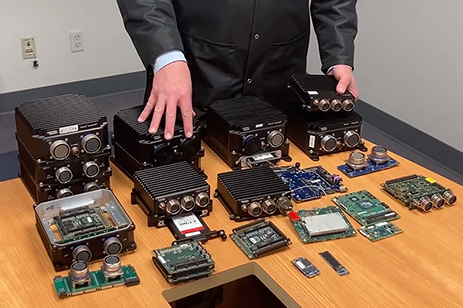
Curtiss-Wright's rugged mission computer subsystems in the small form factor (SFF) Parvus DuraCOR product line feature modular, expandable designs with powerful graphics and data processing capabilities together with ultra-reliable mechanical robustness. Mike Southworth discusses the scalability and modularity of these systems in this video.
Video Transcript
Hi, I'm Mike Southworth. I'm a Senior Product Manager for Curtiss-Wright Defense Solutions and this video is to highlight the scalability and the modularity built into our Parvus DuraCOR Mission Computer line. Shown here on the table are various models that are as small as something that can fit in the palm of your hand to something that is more shoebox-sized, or even larger, as well as many of the open-architecture building blocks that go in the system that enables us to scale the system per customer requirements.
So why is modularity important? Well, as you can imagine, system integrators are upgrading mission computers in C4ISR applications quite routinely in aircraft and vehicle applications where size, weight, and power constraints are very important. Hence why we build systems as small as this. At the same time, these systems need to have the flexibility to be able to interface with the many different legacy or modern sensors, networking devices, and other systems that might be in these platforms.
So a modular mission computer is what allows us to meet the requirements that are common in these C4ISR applications. This range of processors have Intel, they have ARM processors and they have open architecture building blocks. These industrial-temperature building blocks allow us to scale the system to add in functionality to meet specific customer requirements for I/O as well as data storage.
So let me show you some of these building blocks. DuraCORs typically integrate a computer on module like a COM Express card, this is COM Express for Intel Core i7 or Xeon processors or possibly a smart module or system on module for something that's lower power like an Intel Atom processor. Or for an Arm architecture, it might integrate an NVIDIA Jetson module like this and these CPU cards are hosted on carrier boards.
So each of the systems has a carrier board that's optimized for the form factor and the system and the carrier boards themselves have expansion capabilities. You can see here on the back - this is called mini PCI Express. This kind of card is designed to interface with all these carrier boards for functionality such as MIL-STD-1553 or CANbus. Let's say customers need more ethernet ports and digital interfaces, some video encoding or frame grabbing - these kinds of cards come in handy to solve those customer requirements.
This carrier, for example, that hosts a COM Express card on this side and an mSATA storage module on this side. It can also host multiple mini PCI Express cards on this side and you can see a stackable PC104 bus here. So the original stackable PC104, now a PCIU104 is literally a lego-like stacking architecture that can stack multiple cards on top of each other like this with the PC Express bus running through.
These are inherently small and rugged cards. At the same time, while we have these modular board building blocks, we also have mechanical chassis expansion capabilities. So this is an expansion segment and you can see here a system that has been modified with multiple segments. And in each of these segments there can be 3/4 different cards adding in functionality that are specific for the interfaces on board that aircraft or that vehicle.
This is a Lego-like stacking approach, very flexible, and it's based on the ecosystem of industrial cards that exists today that conform to these open architecture standards. Now there is a way to take advantage of this for our customers to reduce the cost to create these. We call it MCOTS, modified COTS, with very low NRE. We have a team of application engineers that takes advantage of the built-in scalability such as the slots here for mini PCI Express or PC104 and removable storage segments, different SSD options such as you are seeing here. This is an M.2 module, this is an mSATA module and 2.5 inch SATA or U.2 are all options with these systems.
This kind of scalability allows our application engineers to recommend the right I/O cards from our trusted suppliers to integrate into the systems. They then document it, test it and provide the software drivers and then ship it to customers with a very reasonable lead time and low NRE expense.
So customers win based on this modular open architecture approach. So in conclusion, customers using the DuraCOR product line gain a very scalable architecture that ranges from very low power to high-performance Xeon systems that have built-in I/O and storage capabilities and scalability to address unique customer requirements. For more information on DuraCOR products, please visit the curtisswrightds.com website.